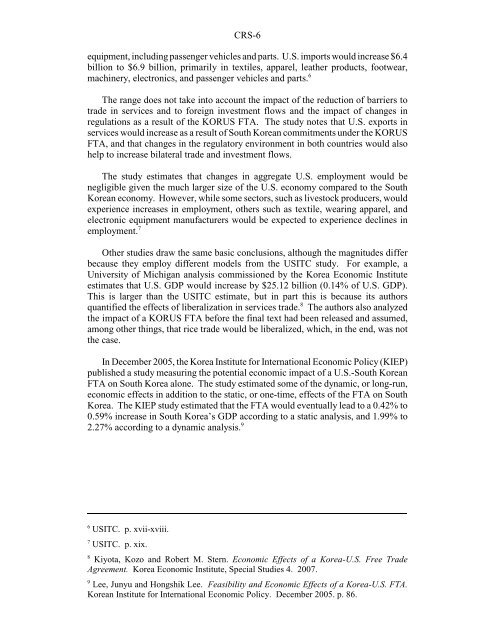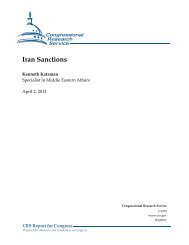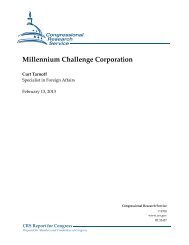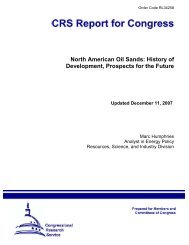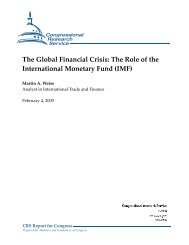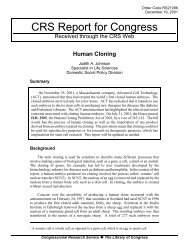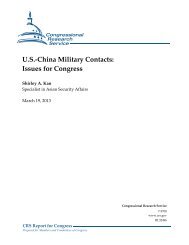The Proposed U.S.-South Korea Free Trade Agreement (KORUS ...
The Proposed U.S.-South Korea Free Trade Agreement (KORUS ...
The Proposed U.S.-South Korea Free Trade Agreement (KORUS ...
- TAGS
- korea
- fpc.state.gov
You also want an ePaper? Increase the reach of your titles
YUMPU automatically turns print PDFs into web optimized ePapers that Google loves.
6 USITC. p. xvii-xviii.<br />
7 USITC. p. xix.<br />
CRS-6<br />
equipment, including passenger vehicles and parts. U.S. imports would increase $6.4<br />
billion to $6.9 billion, primarily in textiles, apparel, leather products, footwear,<br />
machinery, electronics, and passenger vehicles and parts. 6<br />
<strong>The</strong> range does not take into account the impact of the reduction of barriers to<br />
trade in services and to foreign investment flows and the impact of changes in<br />
regulations as a result of the <strong>KORUS</strong> FTA. <strong>The</strong> study notes that U.S. exports in<br />
services would increase as a result of <strong>South</strong> <strong>Korea</strong>n commitments under the <strong>KORUS</strong><br />
FTA, and that changes in the regulatory environment in both countries would also<br />
help to increase bilateral trade and investment flows.<br />
<strong>The</strong> study estimates that changes in aggregate U.S. employment would be<br />
negligible given the much larger size of the U.S. economy compared to the <strong>South</strong><br />
<strong>Korea</strong>n economy. However, while some sectors, such as livestock producers, would<br />
experience increases in employment, others such as textile, wearing apparel, and<br />
electronic equipment manufacturers would be expected to experience declines in<br />
employment. 7<br />
Other studies draw the same basic conclusions, although the magnitudes differ<br />
because they employ different models from the USITC study. For example, a<br />
University of Michigan analysis commissioned by the <strong>Korea</strong> Economic Institute<br />
estimates that U.S. GDP would increase by $25.12 billion (0.14% of U.S. GDP).<br />
This is larger than the USITC estimate, but in part this is because its authors<br />
quantified the effects of liberalization in services trade. 8 <strong>The</strong> authors also analyzed<br />
the impact of a <strong>KORUS</strong> FTA before the final text had been released and assumed,<br />
among other things, that rice trade would be liberalized, which, in the end, was not<br />
the case.<br />
In December 2005, the <strong>Korea</strong> Institute for International Economic Policy (KIEP)<br />
published a study measuring the potential economic impact of a U.S.-<strong>South</strong> <strong>Korea</strong>n<br />
FTA on <strong>South</strong> <strong>Korea</strong> alone. <strong>The</strong> study estimated some of the dynamic, or long-run,<br />
economic effects in addition to the static, or one-time, effects of the FTA on <strong>South</strong><br />
<strong>Korea</strong>. <strong>The</strong> KIEP study estimated that the FTA would eventually lead to a 0.42% to<br />
0.59% increase in <strong>South</strong> <strong>Korea</strong>’s GDP according to a static analysis, and 1.99% to<br />
2.27% according to a dynamic analysis. 9<br />
8 Kiyota, Kozo and Robert M. Stern. Economic Effects of a <strong>Korea</strong>-U.S. <strong>Free</strong> <strong>Trade</strong><br />
<strong>Agreement</strong>. <strong>Korea</strong> Economic Institute, Special Studies 4. 2007.<br />
9 Lee, Junyu and Hongshik Lee. Feasibility and Economic Effects of a <strong>Korea</strong>-U.S. FTA.<br />
<strong>Korea</strong>n Institute for International Economic Policy. December 2005. p. 86.


